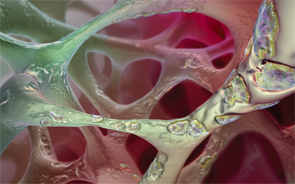
Osteoclast activity is essential in the maintenance, repair and remodeling of bones.
Gary Carlson/sciencesource.com
SAN FRANCISCO—Post-menopausal women with osteoporosis, previously treated with oral bisphosphonates, had greater increases in bone density when taking denosumab compared with zoledronic acid over a year’s time, according to a study presented at the 2015 ACR/ARHP Annual Meeting.
The findings were discussed in the Discovery 2015 plenary session, which focused on new research. In the session, researchers also discussed genetic mutations linked with early-onset auto-inflammatory disease and new findings on the TH17 T cell response in systemic sclerosis.
In the Bones
In the denosumab (DMAb) study, researchers set out to examine the effectiveness of two alternatives to oral bisphosphonates for osteoporosis.1 Oral bisphosphonates are the most commonly used treatment for the disease, but adherence can be low, and not all patients respond well.
Less frequently dosed bisphosphonates—such as once-a-year zoledronic acid (ZOL)—are an option for patients who are intolerant to or have failed oral bisphosphonates. Patients can move from one bisphosphonate to another, but the benefits of that approach haven’t been shown, said Paul Miller, MD, medical director of the Colorado Center for Bone Research, who presented the findings.
The study included post-menopausal women at least 55 years old who had been on oral bisphosphonates for at least two years, with a bone mineral density T-score of -2.5 or worse and C-terminal telopeptide (CTX) levels, a marker of bone breakdown, of no higher than 500 pg/mL.

Dr. Miller
The patients were randomized to the two groups, with 321 in the DMAb group, who were given 60 mg subcutaneously every six months, and 322 in the ZOL group, who were given a once-yearly IV dose of 5 mg of zoledronic acid.
The groups were balanced in terms of age, years since menopause and bone densities.
After 12 months, lumbar spine bone density—the primary endpoint—had increased by 2.1% more in the DMAb group, or more than double what was seen in the ZOL group (P<0.0001). Significantly greater increases were also seen in bone densities for total hip, femoral neck and 1/3 radius.
Levels of CTX and P1NP, another marker of bone breakdown, rose gradually among those on ZOL, but remained relatively constant among those taking DMAb, Dr. Miller showed.
The number of serious adverse events was similar for the two groups.
“In post-menopausal women with osteoporosis who had received prior oral bisphosphonates for at least two years or more, transitioning to denosumab resulted in significantly greater increases in bone density compared with zoledronic acid at all measured skeletal sites,” Dr. Miller said.


